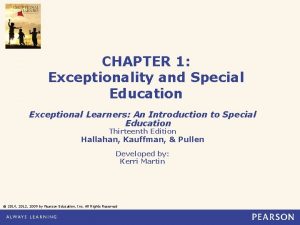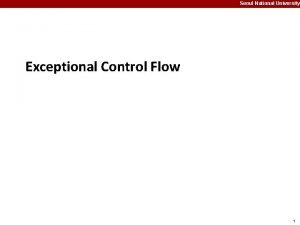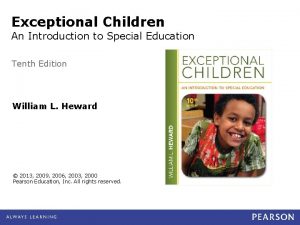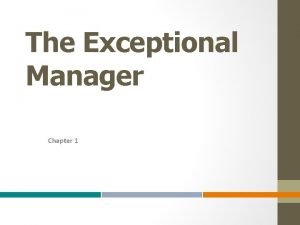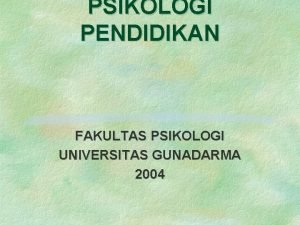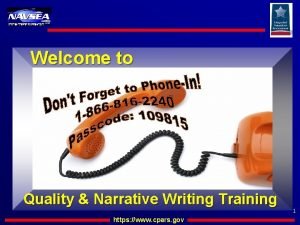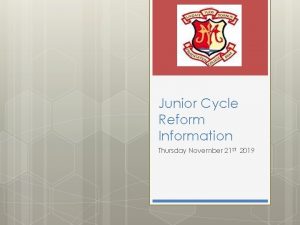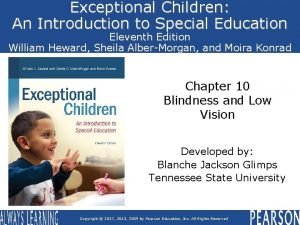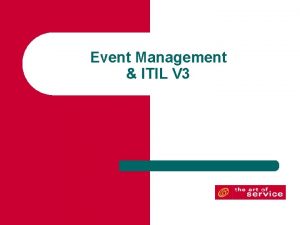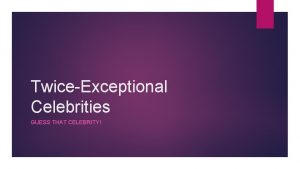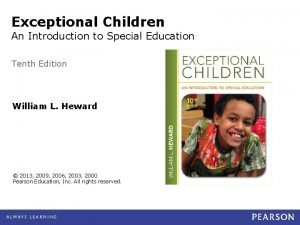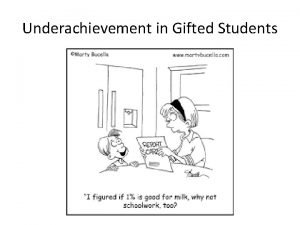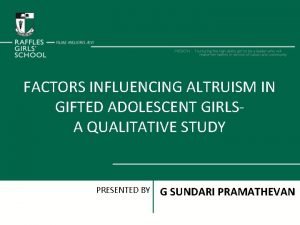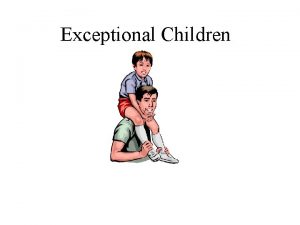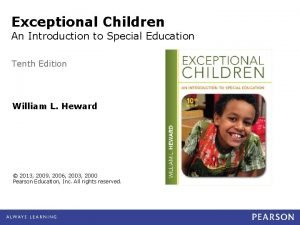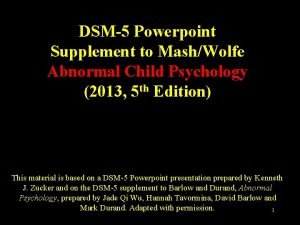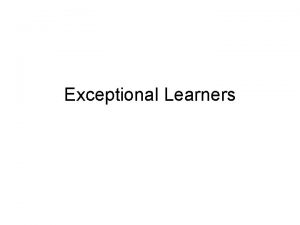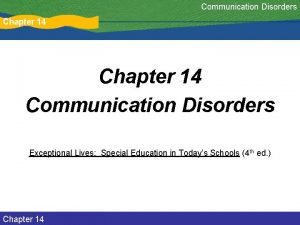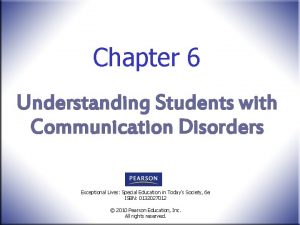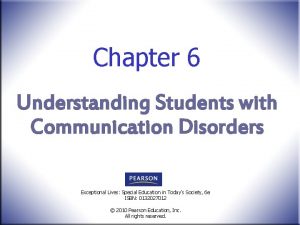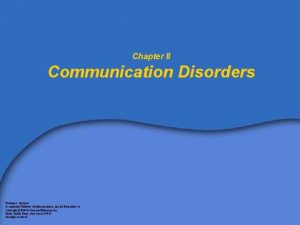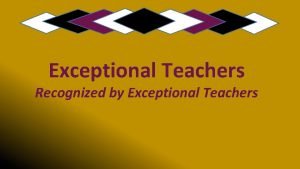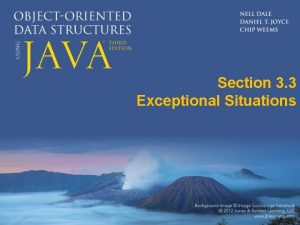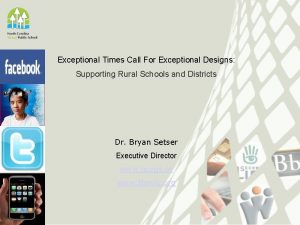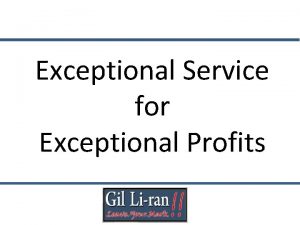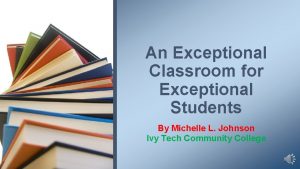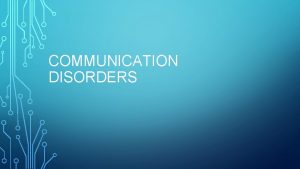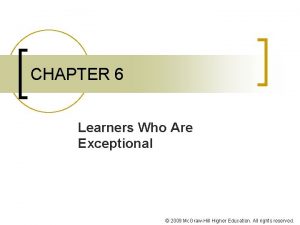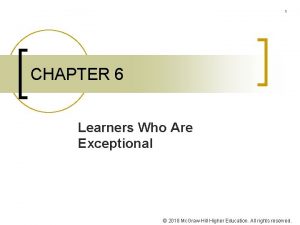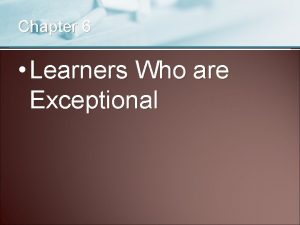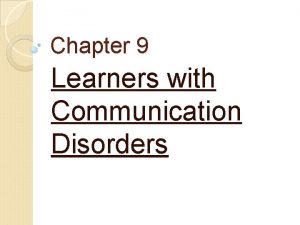CHAPTER 10 Learners with Communication Disorders Exceptional Learners





















- Slides: 21

CHAPTER 10: Learners with Communication Disorders Exceptional Learners: An Introduction to Special Education Thirteenth Edition Hallahan, Kauffman, & Pullen Developed by: Kerri Martin © 2014, 2012, 2009 by Pearson Education, Inc. All Rights Reserved

Topics § Definition of communication disorders § Prevalence of communication disorders § Communicative differences vs. disorders § Major disorders of language § Major disorders of speech § Educational considerations § Assessment of progress § Early intervention and transition Hallahan, Kauffman, & Pullen. Exceptional Learners: An Introduction to Special Education, Thirteenth Edition. © 2014, 2012, 2009, 2006 by Pearson Education, Inc. All rights reserved. 1

Definitions 1 § Communication – process of sharing information, involves communication functions § Communication disorder – impairs the ability to use speech or language to communicate § Language – code or system of symbols used to communicate meaning § Receptive language, expressive language § Speech – formation and sequencing of oral language sounds during communication Hallahan, Kauffman, & Pullen. Exceptional Learners: An Introduction to Special Education, Thirteenth Edition. © 2014, 2012, 2009, 2006 by Pearson Education, Inc. All rights reserved. 2

Definitions 2 § Augmentative or alternative communication (AAC) – alternative forms of communication that do not use oral sounds of speech § Speech disorders – impairment in production and use of oral language § Language disorders – problems in comprehending and using language for communication Hallahan, Kauffman, & Pullen. Exceptional Learners: An Introduction to Special Education, Thirteenth Edition. © 2014, 2012, 2009, 2006 by Pearson Education, Inc. All rights reserved. 3

Definitions 3 §Phonology – rules governing speech sounds §Morphology – rules governing internal organization of words (verb tense, suffixes, etc. ) §Syntax – organizing sentences that are meaningful §Semantics – attaching meanings and concepts to words §Pragmatics – using language for social purposes Hallahan, Kauffman, & Pullen. Exceptional Learners: An Introduction to Special Education, Thirteenth Edition. © 2014, 2012, 2009, 2006 by Pearson Education, Inc. All rights reserved. 4

Prevalence § Extremely varied, difficult to identify, often occur with other disabilities § Speech disorders § 5% of school-age children § Language disorders § 1% of school-age children § Speech-language therapy is one of the most frequently provided related services Hallahan, Kauffman, & Pullen. Exceptional Learners: An Introduction to Special Education, Thirteenth Edition. © 2014, 2012, 2009, 2006 by Pearson Education, Inc. All rights reserved. 5

Communication Variations Dialects are systematic language variations that are rule governed. § Show sensitivity to and knowledge of various cultural values § Ask for help from families and colleagues § Visit students in their natural environments § Interact with students in classroom with their peers § Know and respect features of dialects Hallahan, Kauffman, & Pullen. Exceptional Learners: An Introduction to Special Education, Thirteenth Edition. © 2014, 2012, 2009, 2006 by Pearson Education, Inc. All rights reserved. 6

Research on Language Development § Depends on brain development and proper brain functioning § Affected by consequences of language behavior § Can be analyzed as inputs and outputs related to the way information is processed § Acquired by a biological process that governs form, content, and usage § One of many cognitive skills § Arises from need to communicate in social interactions Hallahan, Kauffman, & Pullen. Exceptional Learners: An Introduction to Special Education, Thirteenth Edition. © 2014, 2012, 2009, 2006 by Pearson Education, Inc. All rights reserved. 7

Classification of Language Disorders § Primary language disorders § No known cause § Specific language impairment (SLI) § Early expressive language delay (EELD) § Language-based reading impairment § Secondary language disorders § Caused by another condition Hallahan, Kauffman, & Pullen. Exceptional Learners: An Introduction to Special Education, Thirteenth Edition. © 2014, 2012, 2009, 2006 by Pearson Education, Inc. All rights reserved. 8

Speech Disorders 1 § Phonological disorders – impaired ability to produce sounds in own language § Phonological awareness § Articulation disorders – errors in producing word sounds § Omissions § Substitutions § Additions § Distortions Hallahan, Kauffman, & Pullen. Exceptional Learners: An Introduction to Special Education, Thirteenth Edition. © 2014, 2012, 2009, 2006 by Pearson Education, Inc. All rights reserved. 9

Speech Disorders 2 § Voice disorders § Pitch § Loudness (aphonia) § Quality (resonance) § Fluency disorders § Dysfluencies § Stuttering § Motor-speech disorders § Dysarthia § Apraxia Hallahan, Kauffman, & Pullen. Exceptional Learners: An Introduction to Special Education, Thirteenth Edition. © 2014, 2012, 2009, 2006 by Pearson Education, Inc. All rights reserved. 10

What is stuttering? Stuttering is a speech disorder. It’s also called stammering or diffluent speech. It’s characterized by: • repeated words, sounds, or syllables • halting speech production • uneven rate of speech Stuttering affects about 5 percent of children ages 2 to 5, according to the National Institute of Deafness and Other Communication Disorders (NIDCD). Most children won’t continue to stutter in adulthood. Typically, as your child’s development progresses, the stuttering will stop. Early intervention can also help prevent stuttering in adulthood. However, the NIDCD also states that some children, less than 1 percent, will continue to stutter as adults. Also, if a child starts stuttering after the ages of 8 to 10, then there is an increased chance that the stuttering will continue into adulthood. Book title, #e Author Name © 2013 Pearson Education, Inc. All rights reserved. 11

What are the types of stuttering? There are three types of stuttering: • Developmental. Most common in children younger than 5 years old, particularly males, this type occurs as they develop their speech and language abilities. It usually resolves without treatment. • Neurogenic. Signal abnormalities between the brain and nerves or muscles cause this type. • Psychogenic. This type originates in the part of the brain that governs thinking and reasoning. Book title, #e Author Name © 2013 Pearson Education, Inc. All rights reserved. 12

What are the symptoms of stuttering? Stuttering is characterized by repeated words, sounds, or syllables and disruptions in the normal rate of speech. For example, a person may repeat the same consonant, like “K, ” “G, ” or “T. ” They may have difficulty uttering certain sounds or starting a sentence. The stress caused by stuttering may show up in the following symptoms: • physical changes like facial tics, lip tremors, excessive eye blinking, and tension in the face and upper body • frustration when attempting to communicate • hesitation or pause before starting to speak • refusal to speak • interjections of extra sounds or words into sentences, such as “uh” or “um” • repetition of words or phrases • tension in the voice • rearrangement of words in a sentence • making long sounds with words, such as “My name is Amaaaaaaanda” Some children may not be aware that they stutter. Social settings and high-stress environments can increase the likelihood that a person will stutter. Public speaking can be challenging for those who stutter. Book title, #e Author Name © 2013 Pearson Education, Inc. All rights reserved. 13

What causes stuttering? There are multiple possible causes of stuttering. Some include: family history of stuttering family dynamics neurophysiology development during childhood Brain injuries from a stroke can cause neurogenic stuttering. Severe emotional trauma can cause psychogenic stuttering. Stuttering may run in families because of an inherited abnormality in the part of the brain that governs language. If you or your parents stuttered, your children may also stutter. Book title, #e Author Name © 2013 Pearson Education, Inc. All rights reserved. 14

How is stuttering treated? Not all children who stutter will require treatment because developmental stuttering usually resolves with time. Speech therapy is an option for some children. Speech therapy can reduce interruptions in speech and improve your child’s self-esteem. Therapy often focuses on controlling speech patterns by encouraging your child to monitor their rate of speech, breath support, and laryngeal tension. The best candidates for speech therapy include those who: • have stuttered for three to six months • have pronounced stuttering • struggle with stuttering or experience emotional difficulties because of stuttering • have a family history of stuttering Parents can also use therapeutic techniques to help their child feel less self-conscious about stuttering. Listening patiently is important, as is setting aside the time for talking. A speech therapist can help parents learn when it’s appropriate to correct a child’s stuttering. Book title, #e Author Name © 2013 Pearson Education, Inc. All rights reserved. 15

Educational Considerations § Facilitating social use of language § Question-asking strategies § Teacher not only instructs about language, but how to use it § Teacher’s own use of language is a key factor § Teaching literacy: reading and written expression § Decoding Hallahan, Kauffman, & Pullen. Exceptional Learners: An Introduction to Special Education, Thirteenth Edition. © 2014, 2012, 2009, 2006 by Pearson Education, Inc. All rights reserved. 16

Assessment of Progress § Language assessment must consider § What child talks about § How child talks about things § How child functions in context of community § How child uses language socially § Progress monitoring § Dynamic assessments § Curriculum-based language and communication assessments (CBLA) Hallahan, Kauffman, & Pullen. Exceptional Learners: An Introduction to Special Education, Thirteenth Edition. © 2014, 2012, 2009, 2006 by Pearson Education, Inc. All rights reserved. 17

Early Intervention 1 § Important for two primary reasons § Smaller chance of success if older § Without functional language, can’t be a truly social being § Early development and early intervention § Nature and quantity of language interactions with caregivers § Early intervention in delayed language development § Prelinguistic communication § Milieu teaching Hallahan, Kauffman, & Pullen. Exceptional Learners: An Introduction to Special Education, Thirteenth Edition. © 2014, 2012, 2009, 2006 by Pearson Education, Inc. All rights reserved. 18

Early Intervention 2 § Involvement of families § Stimulating experiences with caregivers § Intervention in early childhood § Content, form, and use of language in social contexts § Daily individualized conversations § Provide interventions in typical environments, use peers § Sociodramatic play Hallahan, Kauffman, & Pullen. Exceptional Learners: An Introduction to Special Education, Thirteenth Edition. © 2014, 2012, 2009, 2006 by Pearson Education, Inc. All rights reserved. 19

Transition to Adulthood § Three categories of intervention programs § Self-referred § Those with other health problems § Those with severe disabilities § Functional communication skills taught in natural environments Hallahan, Kauffman, & Pullen. Exceptional Learners: An Introduction to Special Education, Thirteenth Edition. © 2014, 2012, 2009, 2006 by Pearson Education, Inc. All rights reserved. 20
 Exceptional learners: an introduction to special education
Exceptional learners: an introduction to special education Exceptional control flow
Exceptional control flow Raleigh & rosse
Raleigh & rosse Exceptional children 10th edition
Exceptional children 10th edition Exceptional manager
Exceptional manager Kategori exceptional people
Kategori exceptional people Cpars quality and narrative writing
Cpars quality and narrative writing Maths cba 1 ideas exceptional
Maths cba 1 ideas exceptional Exceptional children 11th edition
Exceptional children 11th edition Exceptional event in itil
Exceptional event in itil Twice exceptional celebrities
Twice exceptional celebrities What is a cpwa
What is a cpwa Exceptional children 10th edition
Exceptional children 10th edition Twice exceptional kids
Twice exceptional kids Factors influencing altruism
Factors influencing altruism Conclusion of exceptional child
Conclusion of exceptional child Exceptional children an introduction to special education
Exceptional children an introduction to special education Communication disorders (dsm-5 ppt)
Communication disorders (dsm-5 ppt) Chapter 18 psychological disorders review worksheet
Chapter 18 psychological disorders review worksheet Chorionic villus
Chorionic villus Define a primary skin lesion and list three types
Define a primary skin lesion and list three types Chapter 6 musculoskeletal system
Chapter 6 musculoskeletal system
